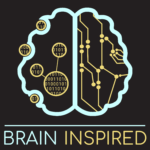


- Grace’s website
- Twitter: @neurograce.
- Models of the Mind: How Physics, Engineering and Mathematics Have Shaped Our Understanding of the Brain.
- We talked about Grace’s work using convolutional neural networks to study vision and attention way back on episode 11.
Grace and I discuss her new book Models of the Mind, about the blossoming and conceptual foundations of the computational approach to study minds and brains. Each chapter of the book focuses on one major topic and provides historical context, the major concepts that connect models to brain functions, and the current landscape of related research endeavors. We cover a handful of those during the episode, including the birth of AI, the difference between math in physics and neuroscience, determining the neural code and how Shannon information theory plays a role, whether it’s possible to guess a brain function based on what we know about some brain structure, “grand unified theories” of the brain. We also digress and explore topics beyond the book.
Timestamps
0:00 – Intro
4:19 – Cognition beyond vision
12:38 – Models of the Mind – book overview
14:00 – The good and bad of using math
21:33 – I quiz Grace on her own book
25:03 – Birth of AI and computational approach
38:00 – Rediscovering old math for new neuroscience
41:00 – Topology as good math to know now
45:29 – Physics vs. neuroscience math
49:32 – Neural code and information theory
55:03 – Rate code vs. timing code
59:18 – Graph theory – can you deduce function from structure?
1:06:56 – Multiple realizability
1:13:01 – Grand Unified theories of the brain

